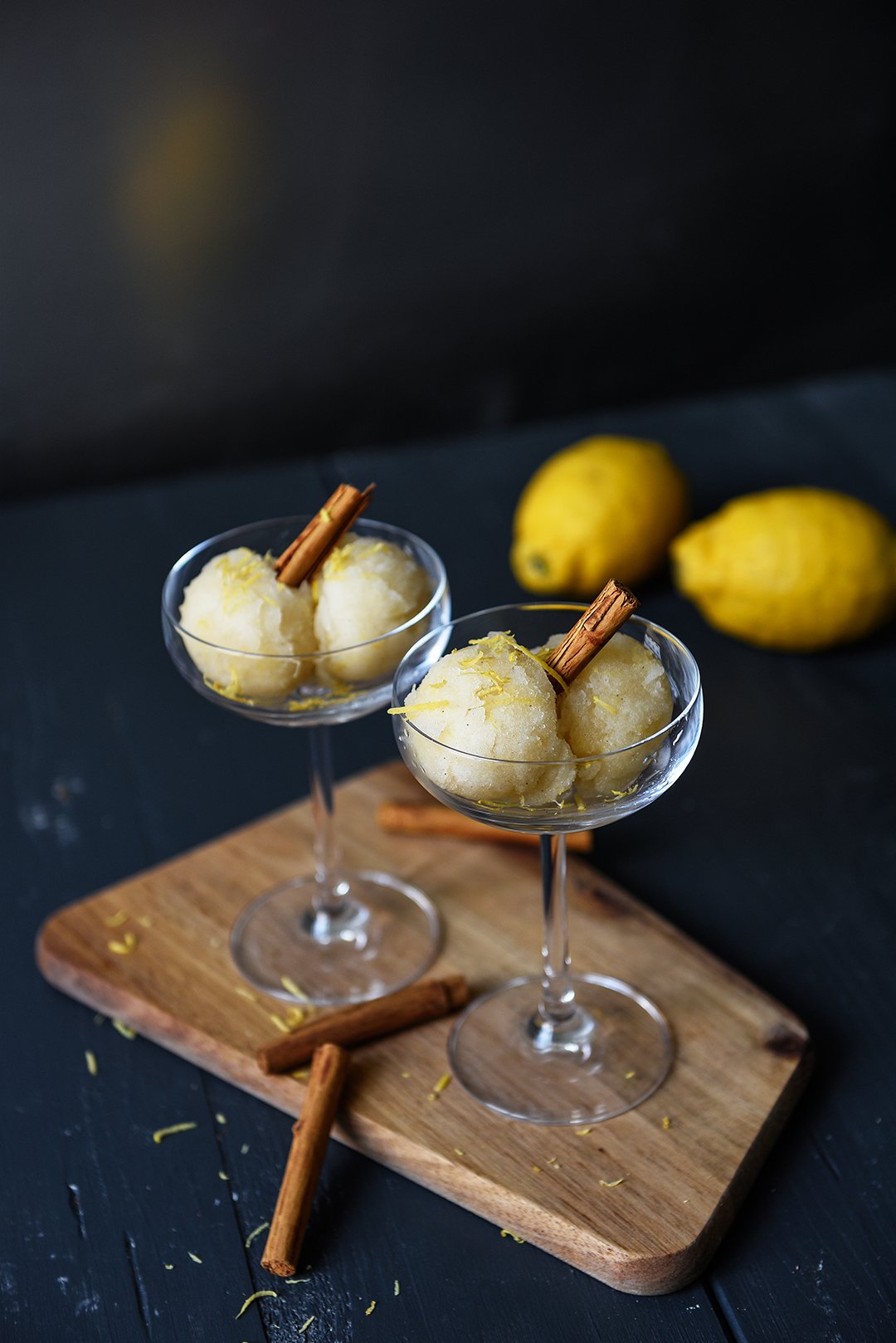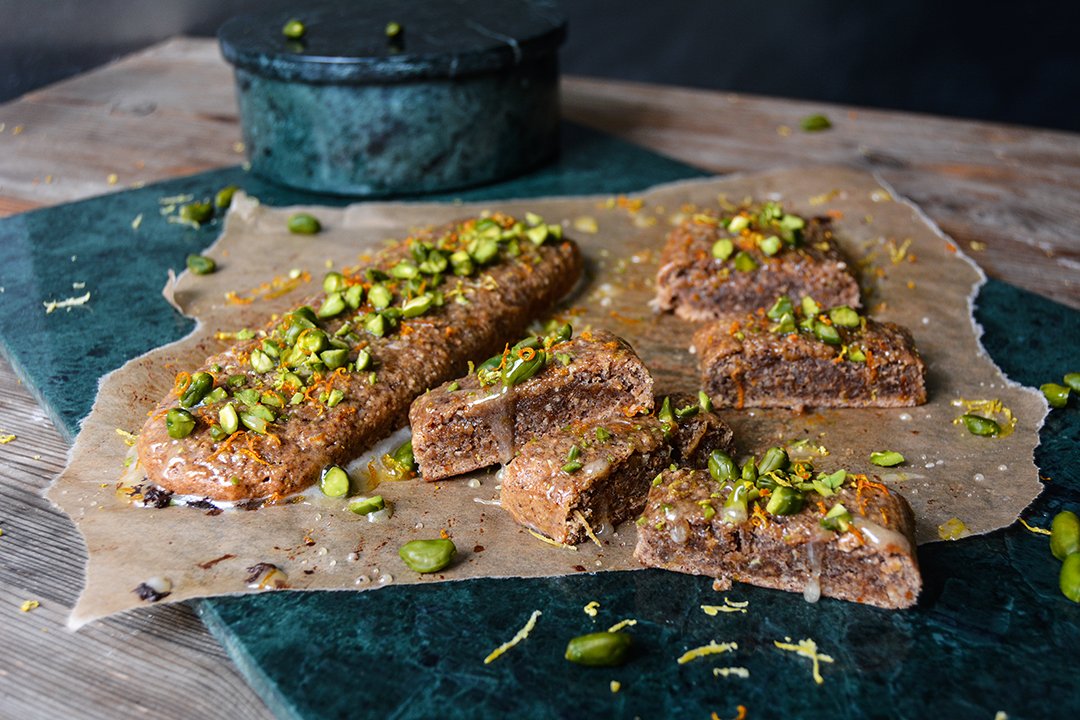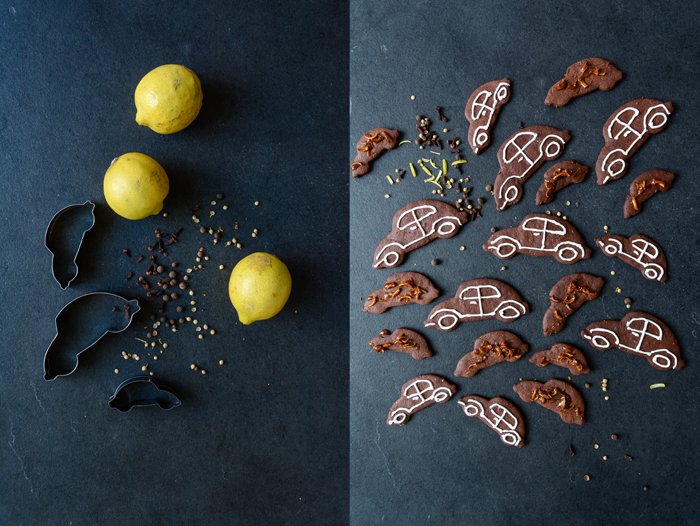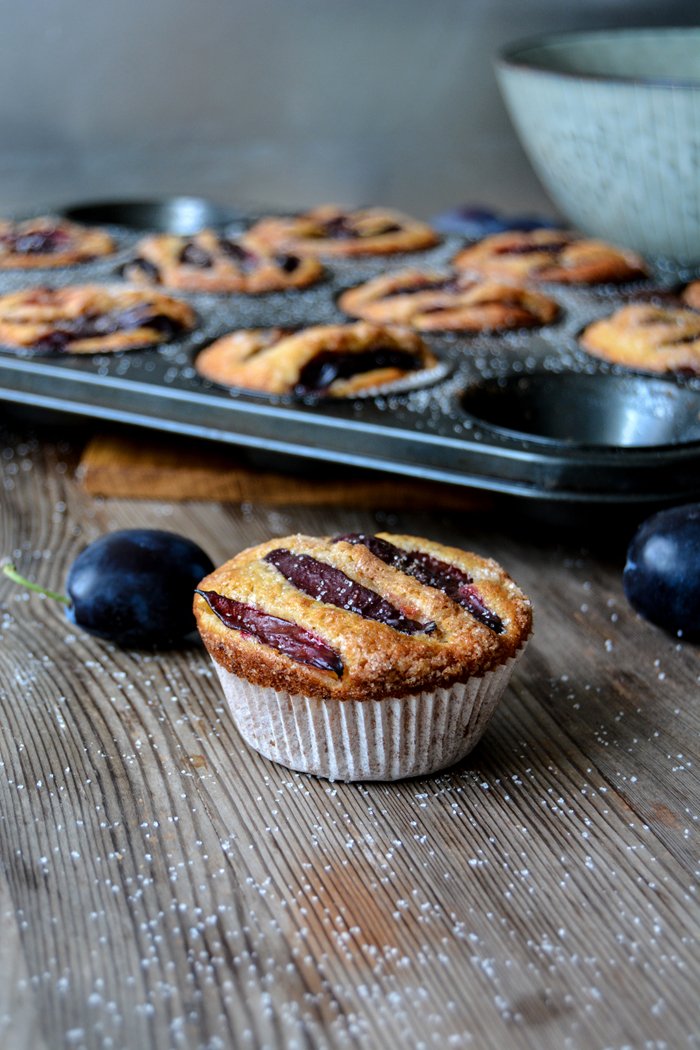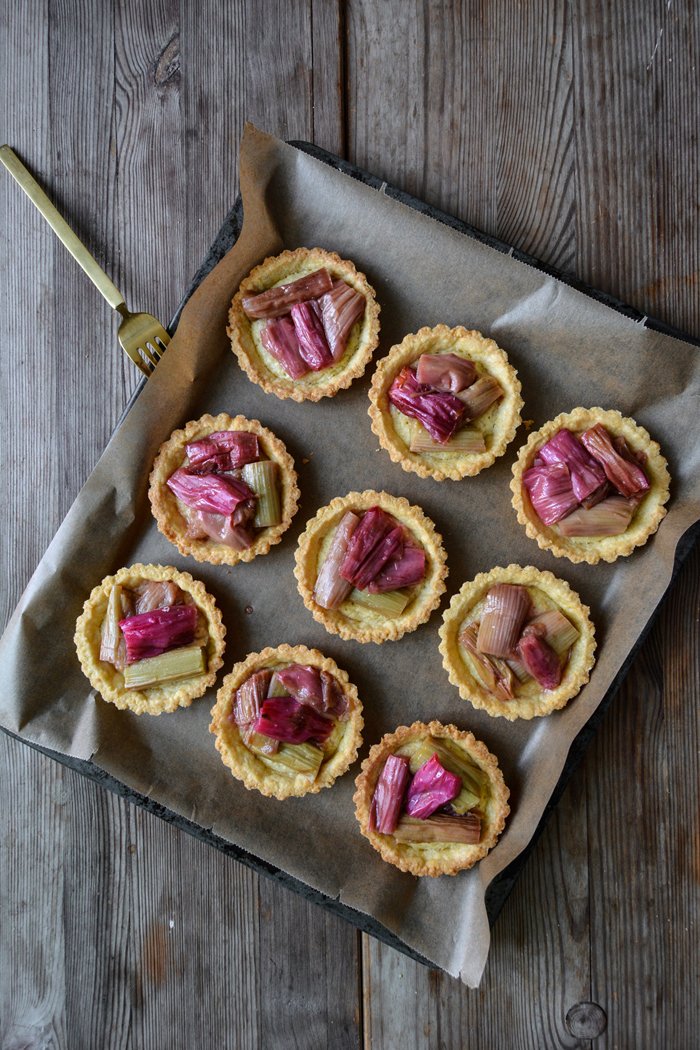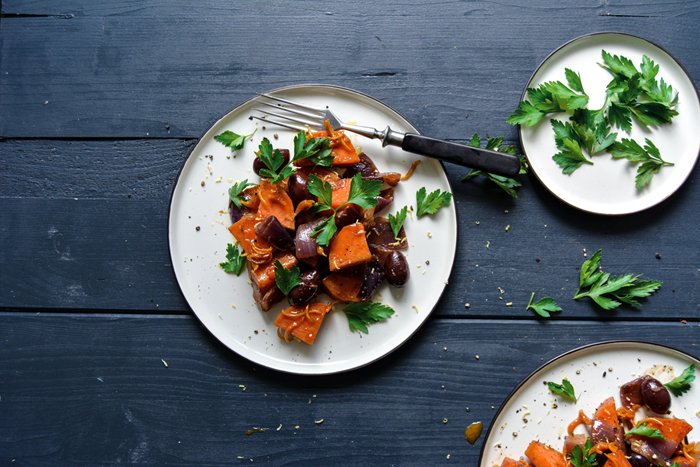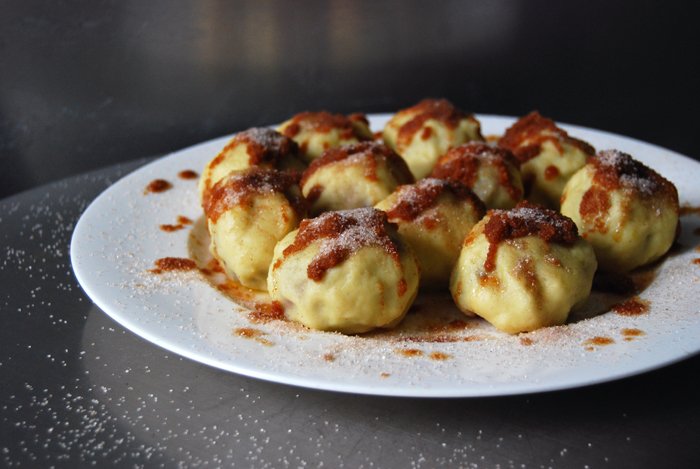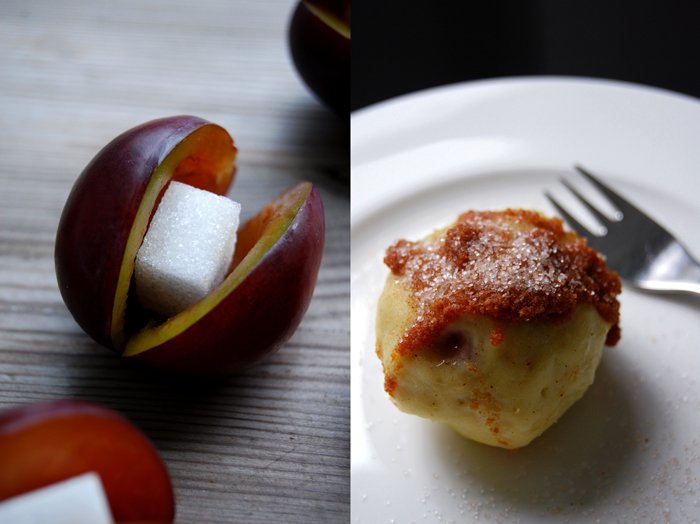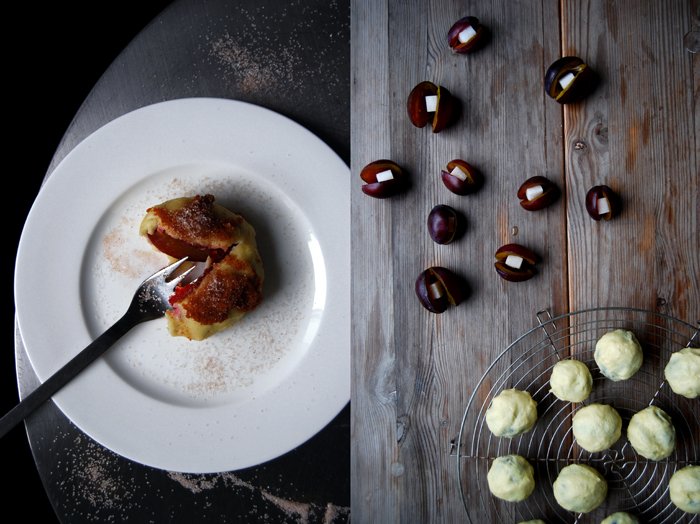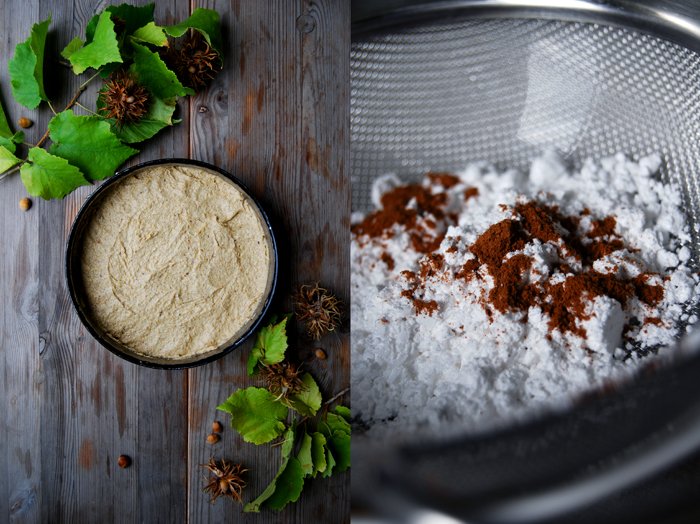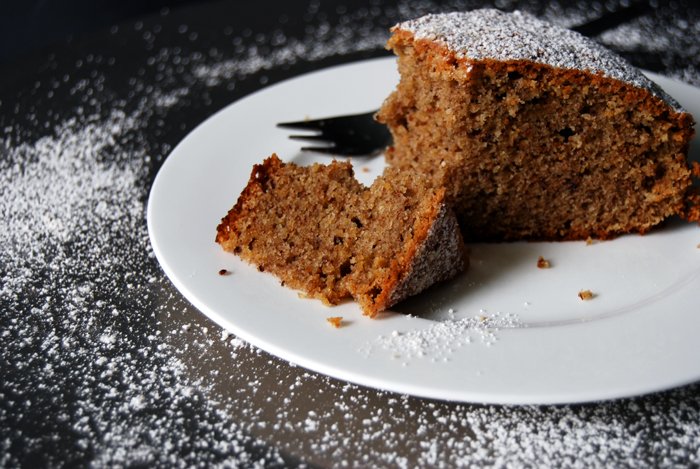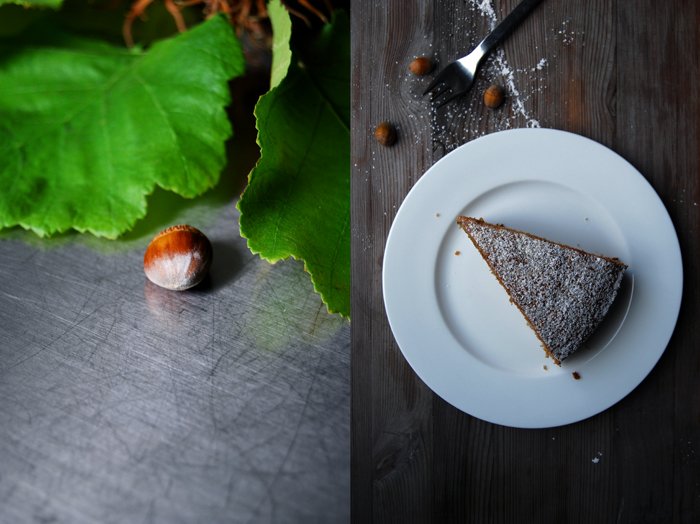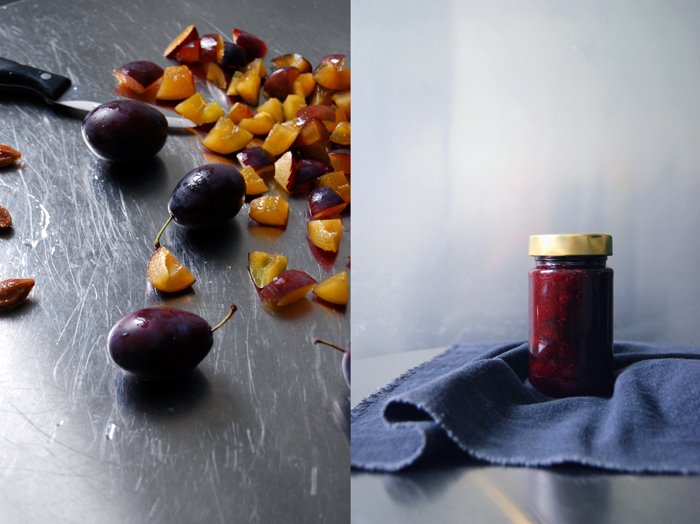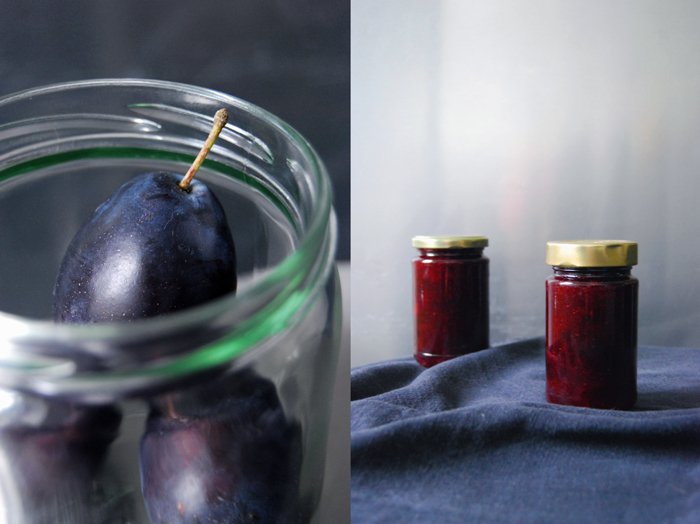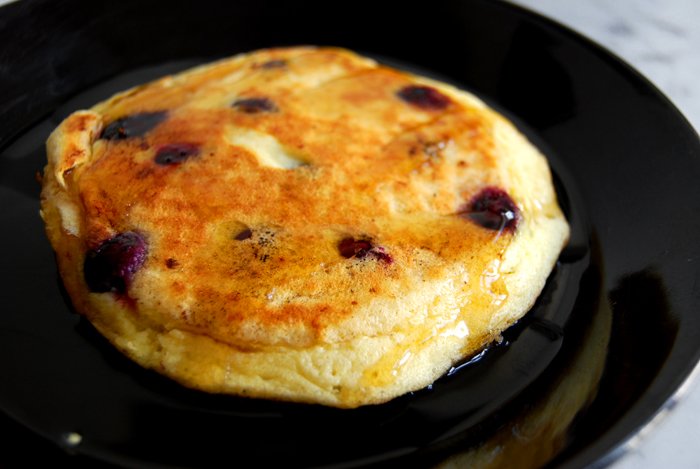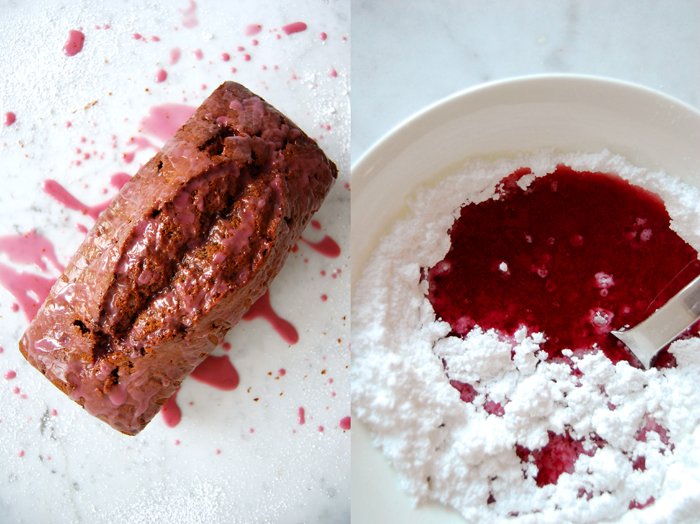Lemon Cinnamon Sorbet & a new book: 365-A Year of Everyday Cooking & Baking
One of the first things I did, once I was done proof-reading my second book 365, was to pull myself straight into the sunshine and to my favorite ice cream shop. I'm not really an ice cream person, but this place makes me happy. Their lemon cinnamon sorbet was the first of many chilled scoops of sweet bliss, and it stayed my favorite. It's very lemony and the aromatic spice is confidently present. I've been wanting to create my own lemon cinnamon sorbet recipe for years and here it is: Chilled heaven on a spoon!
So now that the endless dark months of proof-reading and correcting the English and German 365 are over, days and nights of finding and fixing mistakes and driving everybody (!) around me absolutely crazy with my German hardheadedness and my unbreakable belief that there's always (!) a mistake to find, I'm finely starting to think clearly again, slowly. I've been wanting to share so much about the process of writing a new book here on the blog but at one point I had to accept that there are only 24 hours and 7 days a week. After Eat In My Kitchen, my first book, was so joyfully received and even won a James Beard Award, I wasn't sure how it would feel to start this process all over again. Would I feel intimidated by my own work? No, I wasn't, but I thought it would be just as easy to fill a book with 365 recipes as it felt to share one recipe a day in the first year of this blog in 2014. It wasn't easy back then (I just suppressed the memory) and it was almost insane to do the same thing all over again, just physically, in a printed book.
So the book is done, and it has a name: 365 - A Year of Everyday Cooking & Baking. I'm in love with it now but I hated it at times. I put everything that I am and that I love about food into its pages and I'm happy, overwhelmed, and also scared to see it come into the world (soon, I still have some time to get used to it, it's at the printer right now). I cooked, baked, and shot the pictures about a year ago and - thanks to the wonderful people around me - we managed to make preparing and shooting 8 recipes a day feel like fun. I don't know how, but thinking back on this time still gives me goosebumps. It was magical. I just did what I love the most and fed the people around me with far too much food - it was the best. But then, the time started that I fear the most about working on a book. Turning 365 recipes, hundreds of pictures, notes, and thoughts into printable pages without adding mistakes yet finding the ones that sneaked in, is one of the scariest things. I started dreaming about words and measurements at night! I guess I have to admit that I find comfort in perfectionism (or in the rare moments when we believe we are close to it). But that's not what creating a book is about.
I pity my editor at Prestel Publishing in New York, Holly La Due, who had to go through so many discussions with me about the structure of this book, the cover (a broad field of debate for months!), and all the time have me bagging her to let me triple- and quadruple-check things again and again (until she drew the line - she knows how to deal with her German author).
I'm not yet ready to distance myself and reflect, to see the greater picture, and just chill and let things happen. I'm scared, but I guess that's fine, and despite the inner struggles I can't wait for the day when I can hold the first copy of 365 in my hands. For now, all I can do is share the cover with you (below), and my favorite sorbet recipe.
Update: The English 365 - A Year of Everyday Cooking & Baking was published on October 8th 2019, the German book on September 23rd 2019, and you can order it here:
Lemon Cinnamon Sorbet
Serves 4
270 ml / 1 cup plus 2 tablespoons water
130 g / 2/3 cup granulated sugar
1 generous tablespoon freshly grated lemon zest (about 1 large lemon),plus more for serving (optional)
1 cinnamon stick
A pinch of salt
240 ml / 1 cup freshly squeezed lemon juice (about 5 large lemons)
1/4 teaspoon ground cinnamon
In a small saucepan, bring the water, sugar, lemon zest, cinnamon stick, and salt to a boil over high heat, stirring constantly. Reduce the heat to medium-low and simmer, stirring, for 2 minutes. Add the lemon juice, transfer to a medium bowl, and let it cool for about 10 minutes then chill in the fridge for at least 40 minutes.
Once the mixture is thoroughly chilled, remove the cinnamon stick, whisk in the ground cinnamon, and transfer to an ice cream maker then freeze according to the manufacturer's instructions (it took about 25 minutes in mine). Transfer the sorbet to an airtight container and freeze for 2 to 3 hours. Serve sprinkled with a little freshly grated lemon zest.
If you don't have an ice cream maker, transfer the lemon mixture to a shallow pan and freeze for a few hours or until firm, stirring with a fork every hour to fluff it up.
Kwareżimal - Maltese Easter Sweets without Eggs and Butter
No eggs and no butter, but lots of spice and flavour and a soft and chewy texture. Maltese Kwareżimal are an almost guilt-free pleasure that tastes so good, that I ask myself why I didn't bake them earlier.
This ancient treat dates back to the medieval times, when the Knights in the Mediterranean traditionally baked Kwareżimal during Lent. The little dark brown loaves are made without dairy products, just ground almonds (or hazelnuts in my recipe), spices, and honey create a beautifully fragrant cakey sweet. Sugar was allowed, as it was seen as a spice in those days. It's not a healthy bar after all.
The name derives from the Latin word quaresima, the 40 days of the Lenten season. Although you can find Kwareżimal in some confectionaries on the Maltese islands throughout the whole year, my favourite bakery for sweet treats, Busy Bee, only pulls them out of the oven as Easter is nearing. The problem was that I have never been to Malta around this time, so I had no idea how good Kwareżimal tastes. I knew that I wanted to try them at Busy Bee first and thanks to Jessica and Luke this day has finally come. Our friends visited us a couple weeks ago and gave me - besides many other goods - this plain looking miniature cake as a present. It only took me 12 years to have my first bite of Kwareżimal and it was pure enjoyment. I didn't share a piece with anyone.
So I finally knew what I was aiming for, I felt ready to give it a go. My Kwareżimal are made with ground hazelnuts, as my Maltese man doesn't like almonds, but feel free to use whatever nut you prefer. I mixed in some white spelt flour (plain flour woks just as well) to lighten up the texture. But don't worry, it's still as soft and chewy as it should be thanks to the juice of half an orange.
The texture is divine, almost moist, it reminds a bit of rough marzipan. And it tastes so rich, nutty, and citrusy, with strong tones of rather Christmassy spices, such as cinnamon, cloves, citrus zest, and flowery orange blossom water. I went for a crunchy pistachio topping, bedded on sticky honey running down the sites of my little Kwareżimal. You can also chop almonds or hazelnuts. When you buy this sweet from a shop, you get a single bar, not more than 12cm / 5" long, that was my measure. To serve, I cut it in thick slices - it's a bit like a cookie with a chewy feel.
Kwareżimal
Makes 2 small bars (serves 2-4)
finely ground hazelnuts (or almonds) 120g / 1 cup plus 2 tablespoons
plain flour (I used white spelt flour / type 630) 100g / 3/4 cup
granulated sugar 100g / 1/2 cup
cocoa powder 1 teaspoon
baking powder 1/8 teaspoon
fine sea salt 1/8 teaspoon
ground cinnamon 1 teaspoon
freshly grated nutmeg 1/4 teaspoon
cloves, finely ground in a mortar, 1/2 teaspoon
vanilla bean, scraped, 1/4
freshly grated orange zest 2 generous teaspoons
freshly grated lemon zest 2 generous teaspoonsf
reshly squeezed orange juice 60ml / 1/4 cup
honey 1 tablespoon
high quality orange blossom water (preferably organic) 2 tablespoons
candied orange peel, finely chopped, 1 tablespoon
For the topping
honey 2 tablespoons
freshly squeezed orange juice 1 teaspoon
shelled unsalted pistachios, roughly chopped, a small handful
freshly grated orange zest 1/2 - 1 teaspoon
Preheat the oven to 180°C / 350°F (preferably convection setting) and line a baking sheet with parchment paper.
In a large bowl, whisk together the ground hazelnuts, flour, sugar, cocoa powder, baking powder, salt, cinnamon, nutmeg, cloves, vanilla seeds, orange zest, and lemon zest.
In a small saucepan, heat the orange juice and honey over low heat and whisk until the honey has melted. Take off the heat and whisk in the orange blossom water. Let it cool for a couple minutes, then stir into the dry mixture. Add the candied orange peel and stir until well combined. The dough will be soft, but you should be able to form a bar; if it's too soft, add a little more ground hazelnuts.
Wet your hands lightly, divide the dough in half, and form 2 bars, about 5cm / 2" wide and 2cm / 3/4" tall. Mind that they aren't too flat or they will dry out in the oven. Bake for about 15 minutes, the top of the loaves should still be soft and just slightly baked.
While the Kwareżimal are baking, prepare the topping: in a small saucepan, heat the honey and orange juice over medium heat and whisk until combined. Take the pan off the heat.
Brush the warm Kwareżimal with the warm honey and sprinkle with the pistachios and a little orange zest. To serve, cut into thick slices. Wrapped in cling film, it stays fresh for days.
Chocolate Spice Christmas Cookies with Candied Lemon Peel
I used to have a huge spice box in my kitchen that didn't look very pretty and also wasn't particularly practical. For whatever reason, I decided in my early kitchen years to store all my spice filled glass jars and tiny metal tins in this box and that's where I kept them for two decades. This beaten and buckled box still exists, I just use it for potatoes at the moment (even a box has to stay flexible in life). I used to arrange my spices in two layers of jars, so when I needed juniper berries from the bottom, I would always have to empty the whole thing. Rather impractical.
Around two years ago, I renovated my kitchen, I changed the sink and cupboards on one side of the room. When everything was set up, I had a skype call with my Maltese mama Jenny to proudly present my work to her. Not that she's particularly experienced in kitchen renovation, it's rather the opposite, she still works in her gorgeous sea-blue kitchen gem from the 60s. I don't remember why, but we started discussing the spice-situation in my kitchen. There's a slim cupboard with two sliding drawers next to my sink, so when we had our video chat, we both looked at this drawer and decided that it should become my spice cupboard. I arranged everything that same day and since then I'm more than happy to have such a luxurious overview of my spice collection.
The spices I use the most, right at the front when you open the door, are Maltese fennel and coriander seeds, the whole range of peppercorns in black, green, white, and pink, cinnamon, and cardamom. Jars of cumin, cloves, aniseed, allspice, juniper berries, and mustard seeds are right behind. Then there's the hot section, with cayenne and urfa chilli, plus sumac and a few spice mixtures. I love this cupboard, it's a bit chaotic, and it's still a colourful collection of various jars and containers, but it smells beautiful.
Although I generally prefer a certain order in my kitchen, there are zones and tools in this room that seem to follow their own rules. Cookie cutters, for example, tend to end up in places where I don't even know how they got there. I bought a large metal ring at one point to get my growing collection under control. Every year I buy a couple new ones to add to the classics, to stars, angels, and Santa. I tend to have annual favourites. Squirrel, sausage dog, and deer were popular for a long time, which might speak for my love of cute animals. My collection of three beetles is relatively new, maybe I need a car? Who knows. But apart from giving my cookies a cute look, a cutter should be practical. For example, I barely use the deer anymore because the cookies tend to lose their antlers in the oven, so it looks rather sad. My beetles however are very cooperative, roundish, no narrow parts, and they are even big enough to get a proper royal icing decoration.
I must admit that decorating sweets is not one of my best talents. But I thought it would be nice to bake some cookies at this time of year that you can decorate - especially if there are kids around the baking table. And if you're as lazy as I am and you have a soft spot for citrus, I have a great alternative for you. Decorate half the batch of these delicious chocolate spice cookies with royal icing (I recommend you trust the pros and buy the mixture from a baking shop) and make your children happy. For the other half, caramelize lemon peel until sweet and crunchy, sprinkle this sticky golden mixture over the remaining cookies and make yourself happy. These are the adult cookies. They aren't as pretty as the cute hand decorated ones, but the combination of dark chocolate, cinnamon, cloves, coriander, aniseed, and candied lemon peel makes up for it. They taste so unbelievably good that you won't even mind the looks.
For more delicious recipes and kitchen inspiration, visit Volkswagen's Pinterest community board Food Bloggers for Volkswagen.
Chocolate Spice Christmas Cookies with Candied Lemon Peel
Makes about 50 cookies
For the cookies
plain flour 260g / 2 cups
unsweetened cocoa powder 50g / 1/2 cup
baking powder 1/4 teaspoon
freshly grated lemon zest 1 tablespoon (from 1 large lemon)
ground cinnamon, 1 teaspoon
cloves, ground in a mortar, 10 (about 1/2 teaspoon ground cloves)
coriander seeds, ground in a mortar, 2 teaspoons
aniseed, ground in a mortar, 1/2 teaspoon
allspice berries, ground in a mortar, 4
fine sea salt 1/8 teaspoon
butter, at room temperature, 130g / 1/2 cup plus 1 teaspoon
icing sugar 120g / 1 1/4 cups
organic egg 1
For the decoration
(if decorating half the cookies with royal icing and the other half with candied lemon peel)
royal icing mixture, whisked with a little water, about 60g / 2ounces
granulated sugar 50g / 1/4 cup
water 2 tablespoons
very thin strips of fresh lemon peel, 1 small handful
In a large bowl, combine flour, cocoa powder, baking powder, lemon zest, cinnamon, cloves, coriander, aniseed, allspice, and salt.
In the bowl of a stand mixer, fitted with the paddle attachment, beat the butter and icing sugar until fluffy. Add the egg and mix for about 1 minute or until well combined. Replace the paddle attachment with the dough hook, add the flour-spice mixture to the bowl with the butter, and mix until well combined. Form a thick disc, wrap in cling film and put in the freezer for about 20 minutes.
Preheat the oven to 160°C (325°F) and line 3 baking sheets with parchment paper.
In batches, roll the dough out thinly (about 3mm / 1/8" thick) between cling film and cut out cookies in whatever shape you like. Keep the remaining dough in the fridge while cutting the cookies. Arrange the cookies on the lined baking sheets and bake, one baking sheet at a time, for about 6 minutes or until golden. Let them cool for a few minutes before you transfer them to a cooling rack.
For the royal icing, whisk the royal icing mixture with a little water (following the instructions on the package) and, using a piping bag with the smallest attachment you can find, decorate half the cookies.
For the candied peel, in a small saucepan, bring the sugar and water to the boil. When it starts to caramelize add the lemon peel. Lower the heat to medium and cook for about 3 to 4 minutes or until the peel is golden and soft—mind that it doesn't burn. While the caramel is still liquid (you can leave the saucepan on lowest heat), quickly sprinkle the remaining cookies with the candied lemon peel.
Happy baking!
The Most Perfect Cinnamon Fruit Crumble Cake from the Eat In My Kitchen Book
Guest post by Half Baked Harvest / Tieghan Gerard
Who’s up for cake today?
Cool, because I may just have the best cinnamon apple crumble cake in all the land. All you need to decide is whether to eat it for breakfast, lunch or dinner? Because really, when is cake not the most perfect thing ever? Truth… it’s always perfect, any time of day! But especially this cake, it’s loaded with apples, is crazy buttery, and topped with the most cinnamony crumble ever.
I’m not sure if you guys know this or not, but it’s officially fall cookbook season, and well… there are just so many great new cookbooks being released! I’m really excited to share this recipe with you today because it comes from Meike Peters' new cookbook, Eat in My Kitchen.
Ever since embarking on this journey of writing a cookbook, I’ve realized just how much work goes into writing a book. You guys, it’s no joke!! I am currently working through all the edits, and while I am so excited to be getting closer to sharing the book with you all, it’s also crazy scary…and well, my eyes are slightly tired. Basically I am just praying that when the book is released you guys will all love it to pieces! (Tieghan's first cookbook will be published in 2017)
It’s so awesome that I have the opportunity to help others celebrate their cookbook release by sharing a recipe from their book with you guys! It’s fun for me, and such a great way to let you all in on the books I am loving! SO. Today we are talking about Eat in My Kitchen. Oh man, this book is just packed to the brim with recipes I love, so many great ones and so many that I know you will all love. But when I stumbled on this most perfect cinnamon fruit crumble cake, I knew that this was the recipe I needed to make and share with you all.
Let me just start off by saying that this cake is all kinds of incredible, AND that Meike made it really adaptable to all of the seasons by suggesting three types of fruit you can use – plums, rhubarb or apples. Seeing as I am obsessed with all things fall, and all things honeycrisp apples, I went with apples as my fruit… so, so, so good! What I love most about this cake is that while some fruit cakes can be on the dry side, this cake is anything but. It’s moist, buttery and almost even doughy in the center if you cook it for just under and hour…which I did…and it was perfection.
This cake is somewhat broken up into three layers. The base cake layer, the apple layer and then the crumble layer. All three layers are delicious, but together they truly make for the most perfect cake, and all of that cinnamon sugar crumble atop of those crisp apples… beyond amazing!
This is the perfect cake to serve warm, dusted lightly with powdered sugar. And yes, I do think this cake is acceptable, not only for dessert, but also as a very special (i.e. something to look forward to) breakfast or mid-day snack.
Bottom line: cake like this is great anytime, and since weekdays are usually in need of a little pick me up, you should totally be making this cake after work… It’s the right thing to do – trust me.
Pictures and introduction from Tieghan Gerard, recipe from the Eat In My Kitchen book. Tieghan lives in the mountains, in Colorado, she's the 22 year old founder of the popular food blog halfbakedharvest.com. Visit her and find lots of inspiration in her huge recipe archive! She's currently working on her own cookbook, The Harvest Table, which will be published in Fall 2017.
Thank you Tieghan for taking over the Eat In My Kitchen blog for a day!
The Most Perfect Cinnamon Fruit Crumble Cake
from the Eat In My Kitchen book, published by Prestel, October 2016
Serves 8 to 12
For the cake base
1/2 cup plus 1 tablespoon (125 g) unsalted butter, at room temperature
2/3 cup (125 g) granulated sugar
1/4 vanilla pod, split and scraped
3 large eggs
2 cups (260 g) all-purpose flour
2 teaspoons baking powder
1/8 teaspoon fine sea salt
Choose one of the fruit fillings
2 1/4 pounds (1 kg) pitted plums, cut in half
or 1 3/4 pounds (800 g) trimmed rhubarb, cut into 1 ½-inch (4 cm) pieces
or 5 large sour apples, peeled, cut in half, and cored, the outside of each apple half scored lengthwise (5 times) Tieghan chose apples for this recipe, unpeeled and thinly sliced
For the crumble
1 1/2 cups (200 g) all-purpose flour, plus more as needed
2/3 cup (125 g) granulated sugar
1/4 vanilla pod, split and scraped
2 teaspoons ground cinnamon
1/2 cup plus 1 tablespoon (125 g) unsalted butter, melted, plus more as needed
For the topping
2 teaspoons granulated sugar
1/8 teaspoon ground cinnamon
Preheat the oven to 350°F (180°C) (preferably convection setting). Butter a 10-inch (25 ½ cm) springform pan.
For the cake base, in a large bowl, use an electric mixer to beat the butter, sugar, and vanilla for a few minutes or until light and fluffy. Add the eggs, 1 at a time, incorporating each egg before adding the next one, and beat for 2 to 3 minutes or until creamy.
In a medium bowl, whisk together the flour, baking powder, and salt. Add to the butter-sugar mixture and mix with an electric mixer for 1 minute or until well combined. Scrape the batter into the buttered springform pan and arrange the fruit of your choice on top. Plums and rhubarb work best arranged vertically; apples should be scored side up. Push the fruit gently into the batter.
For the crumbles, whisk together the flour, sugar, vanilla, and cinnamon in a large bowl. Add the melted butter and use the dough hooks of an electric mixer to mix just until it crumbles. If the crumbles are too moist and sticky, add more flour; if they’re too small and don't form large crumbles, add more melted butter. Immediately spread over the fruit, using your fingers to separate any large crumbles.
For the topping, in a small bowl, whisk together the sugar and cinnamon and sprinkle over the crumbles. Bake for about 50 to 60 minutes (slightly longer if using a conventional oven) or until golden on top. If you insert a skewer in the center, it should come out almost clean. Let the cake cool for at least 15 minutes before taking it out of the pan.
Plum, Cinnamon & Buttermilk Muffins
More plums and more muffins!
On Wednesday, I mentioned my unstoppable appetite for plums. I turned the sweet and sour fruit into a caramelized topping for a rich cheese omelette and made a heavenly ciabatta sandwich. Today I turned them into muffins, fluffy muffins, refined with lots of cinnamon and pretty plums on top. I need my sweet dose of homemade cake at least once a week and there's no better day to indulge in this treat than on a Sunday. And if I don't have much time, I go for muffins. A batch of 12 is just enough for the two of us for breakfast and tea time, and the last nibbles are reserved for dessert.
I like to use German plums for baking, also known as Damson plums, but feel free to use Italian plums or any variety you can find. Apples, pears, or blueberry work just as well, I'd even give some late summer peaches or figs a go.More muffin inspiration:
Plum, Cinnamon & Buttermilk Muffins
Makes 12 muffins
plain flour 200g / 1 1/2 cups
granulated sugar 70g / 1/3 cup, plus 2 tablespoons for the topping
baking powder 2 1/2 teaspoons
baking soda 1/2 teaspoon
a pinch of salt
ground cinnamon 1 1/2 teaspoons, plus 1/2 teaspoon for the topping
buttermilk 190ml / 3/4 cup plus 1 tablespoon
butter, melted and cooled, 90g / 1/3 cup plus 1 tablespoon
organic egg 1
large plums 8, cut into thin wedges
paper baking cups 12
Set the oven to 200°C / 400°F (preferably convection setting) and line the 12 molds of a muffin tray with paper baking cups.
In a large bowl, combine the flour, sugar, baking powder, baking soda, salt, and cinnamon.
For the topping, combine the sugar and cinnamon.
In a large bowl, whisk the buttermilk, melted butter, buttermilk, and egg, then pour into the flour mixture. Using a wooden spoon, stir until you have a lumpy dough, with a bit of flour left here and there. Keep in mind, the more you mix it, the more it will lose its light texture. Divide the dough between the muffin cups and arrange the plum wedges on top. For the topping, sprinkle with the cinnamon sugar and bake for about 15 minutes (slightly longer if using a conventional oven) or until the muffins are golden and firm on top. Let them cool for 1-2 minutes before you take them out of the tray.
Rhubarb Tartlets with Cinnamon Oat Crumble
The combination of rhubarb and cinnamon crumble is so perfect that I dare to call it one of my favourite baked sweets. It's sweet, fruity-sour, and buttery, what more could I ask for? I could add oats, which I've never done before for some reason, so I gave it a try and the result was extremely pleasing. The first bite through the crunchy aromatic crust and soft fruit gave me the feeling that home-baked sweets are simply the best.
The past few days were a little rough and rocky and I often wished I had two Meikes to sort out all the tasks and problems piled up on my desk. Late night work led to sleep deprivation and a paranoid me, worrying that I wouldn't manage to finish everything in time. I call myself quite disciplined, I can work hard, but luckily, I also know when to pull the brake. It was a bright and sunny afternoon and I started to feel like I could see the light at the end of the tunnel - although not all problems were solved yet - but I decided to close my laptop. Trying not to think too much, I grabbed my bag and jumped on my bike. Cycling through springy Berlin and enjoying the bumpy ride over cobbled roads put a smile on my face as I saw nature's leaves and blossoms taking over the city again. I stopped at a café for a creamy cappuccino that felt like the best coffee I had in a while, and leafed through a cheesy magazine. Life can be perfect and sometimes it's so easy to get there, all you have to do is forget about your duties for a little while and follow whatever your mood calls for.
Rhubarb Tartlets with Cinnamon Oat Crumbles
Makes 10 tartlets
For the filling
trimmed rhubarb, cut into 5cm / 2" pieces, 600g / 1 1/3 pounds
granulated sugar, 100g / 1/2 cup
For the pastry
plain flour 260g / 2 cups
granulated sugar 80g / 1/3 cup plus 1 tablespoon
a pinch of salt
unsalted butter, cold, 160g / 2/3 cup
organic egg yolks 2
For the oat crumble
rolled oats 100g / 3 1/2 ounces / 1 cup plus 1 tablespoon
plain flour 65g / 1/2 cup
granulated sugar 90g / 1/3 cup plus 2 tablespoons
ground cinnamon 1 teaspoon
unsalted butter, melted, 80g / 1/3 cup
Preheat the oven to 200°C / 400°F (preferably convection setting).
For the filling, add the rhubarb and sugar to a large baking dish and toss to combine. Bake for about 25 minutes or until soft but still in shape. Set the rhubarb aside and let it cool completely.
For the pastry, in a large bowl, combine the flour, sugar, and salt. Cut the butter with a knife into the flour until there are just little pieces of butter left. Continue with your fingers and rub the butter into the flour until combined. Add the egg yolks and continue mixing with the dough hooks of an electric mixer until you have a crumbly mixture. Form a thick disc, wrap in cling film, and put in the freezer for 10 minutes.
Butter 10 (10cm / 4") tartlet pans and dust with flour. Line a baking sheet with parchment paper.Divide the dough into 10 equal parts. Roll out the 10 pieces of dough between cling film into 12 cm / 4 1/2" circles. Line the tartlet pans with the pastry, push the dough into the pans, and prick with a fork. Bake for about 12-15 minutes or until golden, bush the dough down with a fork if it bubbles up. Take the tartlet pans out of the oven and let them cool for a few minutes. Using a metal skewer, loosen the pastry shell gently along the rim and turn the tartlets out onto the lined baking sheet.
Turn the oven down to 180°C / 350°F.
For the crumble, combine the oats, flour, sugar, and cinnamon in a medium bowl. Stir in the melted butter and mix until combined and crumbly.
Divide the rhubarb among the tartlet shells, sprinkle with the oat crumble, and bake for about 15 minutes or until golden brown.
Cumin Cinnamon Sweet Potato with Candied Lemon and Olives
The leaves on the vine in front of my kitchen window are changing their color and start falling as soon as the wind picks up. It's slowly getting colder in Berlin, my wool sweaters replaced my t-shirts and it hasn't taken long for cozy dishes to be back on my mind. Stews and pies, roasts and cookies - my cooking and baking is getting ready for the cold season. I bought the first quince for my spice and fruit flavoured brandy that I'll soon need for all those minced pies and fruit cakes. A pile of small lemons from my kitchen counter has been squeezed into a jar with lots of Mr. Cini's sea salt to preserve and soften them for aromatic lamb shanks. My mood leaves no doubt that I'm ready for winter to come.
I'll still wait a few more days before indulging in the bright orange pleasures of pumpkins, for now I'll enjoy the autumny warmth of sweet potatoes, chopped into chunks and sautéed in fragrant cumin and cinnamon oil. Red onions softened in their velvety juices, plump Kalamata olives stirred in at the end and a few parsley leaves sprinkled on top to wave goodbye to summer. I finished it off with a sweet and tart topping, candied lemon peel tends to stick to your teeth a little but it tastes so good in this composition that I'm willing to compromise.
Cumin Cinnamon Sweet Potato with Candied Lemon and Olives
Serves 2
olive oil
ground cumin 1 teaspoon
ground cinnamon 1/8 teaspoon
medium red onions, cut in half and quartered, 2
sweet potato, peeled, quartered and cut into 1 1/2 cm / 1/2" slices, 430g (15 ounces)
freshly squeezed orange juice 3 tablespoons
white wine 3 tablespoons
water 6 tablespoons
coarse sea salt
black peppercorns, crushed in a mortar
lemon zest 1 heaping teaspoon
Kalamata olives 6
a few parsley leaves
For the candied lemon peel
long, wide strips of lemon, peeled off the fruit with a vegetable peeler, 5 (without the white pith)
freshly squeezed lemon juice 4 tablespoons
water 4 tablespoons
granulated sugar 3 tablespoons
For the candied peel, bring the strips of lemon peel, juice, water and sugar to a boil in a saucepan and simmer for about 15 minutes until golden and soft but not dark. Set aside.
Heat a generous splash of olive oil with the cumin and cinnamon in a heavy pan. When the pan is hot, add the onions and cook for about 5 minutes on medium-high heat until soft, stir once in a while and mind that they don't turn dark. Add the sweet potato, stir well and cook for 2 minutes. Deglaze with the orange juice, pour in the wine and water and season with salt and pepper. Stir in the zest and turn the temperature down to a medium-low. Close the pan with a lid and cook for about 10 minutes until the potatoes are just soft but still in shape. Stir in the olives and season to taste, take the pan off the heat, cover and let everything sit for a few minutes.
If the candied peel became hard, put the saucepan back on the heat to soften them. Divide the sweet potatoes between the plates, sprinkle with crushed pepper, candied peel and fresh parsley.
Cinnamony Plum, Buckwheat and Hazelnut Cake
What a week! My boyfriend played at a festival in Malta, in Valletta's Royal Theatre (Pjazza Teatru Rjal), and as I'm his biggest fan I obviously had to go with him. It was supposed to be a little break from my busy schedule but life had a different plan. Our luggage got lost on its way to the Mediterranean, including most of his instruments. So, I didn't get to spend my days at the beach - as I had planned - but on the phone instead, calling airlines and airports to find our stuff. Two days later it arrived - just in time! We picked it up (I have never been so happy to see a suitcase) and drove straight to the beautiful venue at the entrance of Malta's capital. The show was fantastic and we were all happy but the drama didn't end there. On Sunday, my youngest Maltese sister Julia moved to Scotland and the whole family escorted her to the airport to wave goodbye, to laugh and cry. Her mother Jenny, Granny Edith, all the siblings, aunts, uncles and cousins were there. Exhausted but happy to see the young girl safely on her way to the North, we ended up in Floriana, at a large table at one of the gabbanas. Our simple bistro-restaurant was set right at the harbour where all the big cruise ships depart, it was a gorgeous clear night. The moon was bright red and I soon found a huge Maltese pizza in front of me and enough red wine to save me from insanity.
The following few days were filled with exciting visits and news that I will soon share with you. I visited Alex and Benjamin in their old palazzo in Żebbuġ for a new meet in your kitchen feature (coming soon!), we cooked together and enjoyed a scrumptious lunch with great people. They also introduced me to Marina, the inspiring woman runs a little café at the breathtaking Villa Bologna. I went to see her magical place the next day and fell in love. We sat in the park, drank her fantastic ice tea and I was treated to the most delicious apricot clafoutis and two kinds of ice cream: cardamom marmalade and yellow plum. This woman knows how to make her guests feel home! We clicked immediately and have quite a few ideas together for the future ... And here's another gem I dug deeper into this time - Mdina Glass. I visited the traditional glass manufacturing hall and looked right into the 1400°C (2550°F) hot oven where the glass is made - again, more to come soon.
And here's the last exciting news: my brother's first baby was born - and I'm an aunt again! Welcome little girl!
Now, I'm exhausted and ready for a cozy Sunday on the sofa with a large piece of my plum, buckwheat and hazelnut cake. It's an honest cake, nutty and cinnamony, not too sweet and gluten-free, with juicy late summer plums - sweet sofa heaven. Enjoy your weekend!
Cinnamony Plum, Buckwheat and Hazelnut Cake
For a 26cm / 10″ springform pan
ground hazelnuts 225g / 8 ounces
buckwheat flour 225g / 8 ounces
cinnamon 2 teaspoons
baking powder 4 1/2 teaspoons
organic eggs, separated, 6
a pinch of salt
butter, at room temperature, 250g / 9 ounces
granulated sugar 200g / 1 cup
plums, pitted, 800g / 1 3/4 pounds
For the topping
granulated sugar 2 tablespoons
cinnamon 1/4 teaspoon
Set the oven to 180°C / 350°F (fan-assisted oven).
Combine the hazelnuts, buckwheat, cinnamon and baking powder.
Beat the egg whites and salt until stiff.
In a large bowl, beat the butter and sugar until fluffy. Add the egg yolks, one at a time and continue mixing for a few minutes until the mixture is thick and creamy. Gently fold the dry mixture and the egg whites with a wooden spoon into the butter and sugar mixture, alternating 1/3 at a time, combine well in between. Scrape the dough into a loose bottom springform pan, even it out and arrange the plums in circles on top, push them into the dough. Sprinkle half the cinnamon sugar over the cake and bake for about 50-55 minutes or until golden brown on top. Check with a skewer, it should come out clean. Sprinkle with the remaining cinnamon sugar and let it cool for a few minutes before you take it out of the spring form pan. Enjoy pure or with vanilla ice cream or whipped cream.
Loukoumades - Greek Doughnuts with Honey, Cinnamon and Pistachios
Every year at carnival, my family meets at my mother's house to make Berliner, a jam filled doughnut dusted with cinnamon sugar. It's a heavenly ball of sweet sponginess so tempting that all of us end up eating far more than we should. We all have our favourite filling, so we use a selection of blueberry, raspberry, blackberry and red currant jam. The only problem is, once they are cooked, you can't really see the difference anymore. So we guess blindly and exchange Berliner across the table when we pick the wrong one. It's quite a funny scene! You could also use chocolate, gianduja or eggnog to customize them to your personal taste and come up with your own perfect creation. Unfortunately, after this culinary experience, you might never be satisfied with store-bought doughnuts ever again! It's already been a year since I shared our traditional Berliner recipe, and next week, it will be that time of year again, we'll all meet in my mother's kitchen in the countryside to celebrate our silly little family feast!
Although I'm not the biggest fan of deep-fried sweets, at carnival I love them. They belong to this season like spooky costumes and exuberant music. In Cologne, where I went to university, I used to buy Muzen from a little bakery. They look like tiny diamond shaped doughnuts, crisp on the outside with a spongy centre. It's a local speciality only made at this time of the year. They are so good, I could eat them by the dozen! In Berlin, Berliner are called Pfannkuchen (meaning pancakes in German) and they are often filled with plum jam. There are many other names all over the world, Krapfen, Fastnachtküchle, Krof in Slovenia or Pączki in Poland, all customized after the regional preferences.
After some research, I discovered something new, Greek doughnuts called Loukoumades! I called my sister as her husband is half Greek and they often spend their summers in Greece. Nina got very excited about this sweet and told me that they savoured it all the time during their last holiday on the island of Thassos. Her husband would play Bouzouki in a mountain village in the evenings with his friends while my sister enjoyed plates of Loukoumades, with lots of honey and cinnamon. After her colourful description, my decision was made, I had to try them! The next morning I made an orange flavoured yeast dough, a bit softer and with more yeast than my usual recipe. You have to scoop out the little Loukoumades with a spoon and cook them in hot fat. It only took a few minutes and I had a plate full of golden doughnuts in front of me, coated voluptuously with orange-honey syrup and sprinkled with chopped pistachios and a bit of cinnamon. It was amazing, I know I can trust my sister when it comes to sweet treats!
Loukoumades with Honey, Cinnamon and Pistachios
For 24 small Loukoumades you need
plain flour 400g / 14 ounces
dry yeast 2 sachets (each 7g / 1/4 ounce)
granulated sugar 1 tablespoon
salt 1 teaspoon
milk, lukewarm, 150ml / 5 ounces
water, lukewarm, 125ml / 4.5 ounces
orange zest 1 heaped teaspoon
honey 1 tablespoon
pistachios, unsalted, chopped, 60g / 2 ounces
ground cinnamon, for serving
vegetable shortening for deep-frying 1kg / 2 1/4 pounds
For the syrup
quality honey (liquid) 150g / 5.5 ounces
freshly squeezed orange juice 50ml / 1 3/4 ounces
granulated sugar 1 tablespoon
orange zest 1 teaspoon
In a large bowl, combine the flour, yeast, sugar and salt. Add the milk, water, honey and zest to the mixture and mix with the dough hooks of your mixer for about 5 minutes. The dough should be elastic and come off the sides of the bowl, it will be a little sticky so don't mix with your hands. Cover the bowl with a tea towel and let it rise in the warm oven (35°C / 95°F) for 45 minutes (top/ bottom heat and not fan-assisted!).
For the syrup, bring the honey, orange juice and sugar to the boil and cook on medium heat for about 5 minutes or until it's a thick syrup. Stir in the zest and keep warm.
In a large pot, heat the vegetable shortening. Check the temperature with a wooden spoon, it's hot enough when little bubbles form around it. Scoop out a small walnut sized ball off the dough (this works best with 2 tablespoons) and carefully drop it into the hot fat. Start off with one ball, the Loukoumades should cook for 3-4 minutes to turn into golden balls. If they become too dark after a shorter cooking time, turn down the temperature (which is what I had to do after the first batch), they will need at least 3 minutes for the centre to cook through. They should be golden and not dark brown. Take them out with a slotted ladle and put them on a kitchen paper to remove excess fat. Serve with the warm syrup, chopped pistachios and a little cinnamon.
Plum Dumplings with Cinnamon Breadcrumb Butter - Swabian Zwetschgenknödel
Plums, potato dough, browned breadcrumb butter, sugar and cinnamon - this southern German sweet doesn't call for many ingredients but it puts them together in just the right way. The result is heavenly: sweet plum dumplings with browned breadcrumb butter and cinnamon sugar - or in German - Zwetschgenknödel!
My versatile Gnocchi dough makes another appearance for this recipe. For Friday's Bavarian beer roasted pork, I recommended savory potato dumplings with the same dough. For this traditional Swabian dish, I use it to wrap sweet and sour plums with a thin layer of the potato mixture to turn the blue fruits into sweet, fruity dumplings.
Whenever I make this recipe, I consider reducing the amount of butter and sugar for just a split second, but luckily I never do. This dish really needs all the lusciousness of its decadent topping. I learnt about these dumplings from my Swabian step father Uli and he taught me that a dessert is there to enjoy and not about counting calories. Every time we make the Knödel together in my mother's kitchen, he reminds us to keep the potato dough layer very thin, that's how he learnt to do it from his mother and grandmother. It's our job to form the dumplings but it's his to take care of the quality control, and he is a very picky instructor!
It can be a bit fiddly getting the little balls in shape, to make it a little bit easier you should use small plums like Damsons and keep your fingers moist while you're working with the dough.
Plum Dumplings with cinnamony Breadcrumb Butter - the Swabian Zwetschgenknoedel
For about 30 plum dumplings you need
small plums (like Damsons) 30 (about 800g / 2 pounds)
sugar cubes 30
Cut the plums open on one side, take out the seed and fill each fruit with a sugar cube, close the fruit as well as possible.
For the topping
butter 100g / 3.5 ounces
dry breadcrumbs 50g / 2 ounces
granulated sugar 50g / 2 ounces
ground cinnamon 1 teaspoon
Combine the sugar and cinnamon.
In a sauce pan, melt the butter with the breadcrumbs. Cook the mixture for a few minutes on medium-high temperature until golden brown. Don't let it burn or it will taste bitter.
For the potato dough
potatoes, cut into cubes, 450g / 16 ounces
butter 30g / 1 ounce
organic egg yolks 2
plain flour 120g / 4.5 ounces
salt 1/2 teaspoon
Cook the the potatoes in salted water until soft (around 15 minutes), drain them when they are done. Press the drained, warm potatoes through a potato ricer and mix immediately with the butter and egg yolks. Let the mixture cool completely before you continue with the next step!
With a spoon (or your hands), mix the cold potato mixture with the flour and salt until combined.
The plum dumplings
Your fingers should be wet while you're forming the dumplings, so keep a little bowl of water right next to you.
In a large pot, bring lots of water with 1/2 teaspoon of salt to the boil.
With a tablespoon, take a walnut sized ball of the potato dough. Shape a flat ball and lay it flat in the palm of your moistened hand, pushing down the middle with the thumb of your other hand. Lay the plum (cut side down) into the center of the dough and gently start pushing and rolling up the dough until the whole fruit is covered with a thin layer (the blue of the plums will be just visible in some places, see my second to last picture). If the dough starts tearing, take a little bit more to cover the fruits. Place the dumplings on a grid until you're done with all of them (when you take the dumplings off the grid you might have to even out the grid's mark with your fingers).
Poach the dumplings in batches in the hot but not boiling water (simmering) for about 8-10 minutes or until they start to float on the surface. Take the dumplings out with a slotted ladle and let them drain on a grid for a few seconds.
Put the cooked dumplings into a large bowl or onto a plate, pour over the warm browned breadcrumb butter and sprinkle the cinnamon sugar on top.
Hazelnut and Buckwheat Cake with Cinnamon Icing Sugar
Family guests from LA! Our American grandfather Jim and his wife Gina came to visit us and - as always when guests stay with us - we let the feast begin from day one! When they arrived at noon, we sat down at our long wooden table and we only got up in the early evening, after hours of savoring. I carried one dish after the other to the table, so much so, that at one point my boyfriend stated I must have mistaken his grandparents for goats! There was so much to talk about, so many memories and stories to share, so much to show after years of not seeing each other, that a good amount of nice food seemed like the perfect company for a day like that. Also, it was a very successful way to fight their jet lag. 9 hours of time difference and my food kept them awake till 9!
One of my personal table highlights of that first day was my hazelnut and buckwheat cake. I love to welcome friends and family with a cake on the table. The sweet smell of freshly baked food in the house wakes you up even after the longest flight and makes you feel home right away! I had been in the mood for a cake like that for days, simple and spongy with the deep flavour of hazelnuts and I got what I asked for. I made the dough with ground nuts and buckwheat which adds a nuttiness to it that I wouldn't have achieved with wheat or spelt flour. It's a very popular combination in the Tyrolean mountains which always start to have a growing influence on my cooking and baking as soon as the temperatures drop. So it's a mountain cake, honest and rich in taste, refined with lots of cinnamon mixed in and sprinkled on top with some icing sugar.
I wanted to put even more food on the table, but at one point, they all stopped me. My plan was to finish the day off with my famous Swabian Cheese Spaetzle, hearty cheese and onions with homemade southern noodles, but they didn't let me go back to my kitchen! I saved it for another night and dinner and they loved it, like the Blue Cheese Crackers, Beluga Lentils with Pear, Tyrolean Plum Dumplings, Sicilian Chard, Radicchio Crespelle and all the other goodies I will write about in the coming days!
Hazelnut and Buckwheat Cake
For one 26cm / 10" springform pan or two 18cm / 7" pans you need
ground hazelnuts 225g / 8 ounces
buckwheat flour 225g / 8 ounces
granulated sugar 200g / 7 ounces
ground cinnamon 1 teaspoon plus more for dusting
baking powder 4 1/2 teaspoons
a pinch of salt
butter, at room temperature, 250g / 9 ounces
organic eggs 6
icing sugar for dusting
Set the oven to 180°C / 350°F (fan assisted oven).
Combine the dry ingredients.
Beat the egg whites and salt until stiff.
Beat the butter and sugar until fluffy. Add the egg yolks, one at a time and continue mixing for a few minutes until the mixture is thick and creamy.
Gently fold the dry mixture and the egg whites with a wooden spoon into the butter and sugar mixture, alternating, 1/3 at a time, combining well in between.
Bake for 35 minutes (or a bit shorter if you use smaller pans) or until golden brown on top. Check with a skewer, it should come out clean. Let it cool for a few minutes.
Combine 2-3 tablespoons of icing sugar with 1/4 teaspoon of cinnamon and sprinkle over the cake.
Cumin Cinnamon Aubergine with Capers and Orange Polenta
Today, all the warm colours of autumn are combined on my plate, brown cumin, golden cinnamon, green capers, purple aubergine and bright oranges! The transition from summer to the next season brings the spices back into my cooking, my big spice box is out almost every day! In June, July and August, I follow my love for fresh, woody herbs, rosemary, thyme, oregano or fleshy sage, mint or basil leaves, but now it's time for some exotic mixtures again. Salty and citrus flavours mixed with earthy cumin and sweet cinnamon. It works great, and the juicy aubergine, with its unobtrusive taste stands up surprisingly well and holds it all together.
I got all excited surrounded by these deep aromas in my kitchen, so I decided to try out something new when I mixed the cornmeal into the milk for my polenta. I cooked it with a few strips of orange zest, I didn't want it to be pure and naked next to the rich composition I prepared for the aubergines. It was a wonderfully warming dish, in colour and taste, a little bit surprising in flavours, but really, really good! So good, that I already bought a couple more aubergines for the next batch!
Cumin Cinnamon Aubergine with Capers and Orange Polenta
For the aubergine
aubergine, cut into small cubes (1/2cm / 1/4"), about 200g / 7 ounces
garlic, crushed, 2 cloves
cumin 1/4 teaspoon
cinnamon 1/4 teaspoon
capers, rinsed and drained, 1 tablespoon
freshly squeezed orange juice 50ml / 2 ounces
orange zest 1/2 - 1 teaspoon
balsamic vinegar 1 teaspoon
olive oil
salt
In a large pan, heat a splash of olive oil, the garlic, cumin, cinnamon and capers for 1 minute, stirring constantly. Add a little more oil and the aubergine and cook for 5 minutes on medium heat or until the aubergine is golden and soft. Deglaze with the juice and season with vinegar and salt to taste. Sprinkle with orange zest and serve with the warm polenta.
For the polenta
polenta 120g / 4 ounces
water 250ml / 8.5 ounces (plus around 100ml / 3.5 ounces for cooking)
milk 250ml / 8.5 ounces
salt 1 teaspoon
olive oil 2 tablespoons
orange peel 3 long strips
In a sauce pan, heat the water and milk, add the salt and bring to the boil. Take the pan off the heat, add the olive oil and polenta and whisk. Add the orange peel, turn down the heat to the lowest temperature and put the pan back on. Cook the polenta for 10 minutes mixing and adding more water once in a while.
Tyrolean Plum Jam with Cinnamon and Star Anise
This is the kind of jam I would eat for breakfast in the mountains, in an old wooden hut, the morning table strewn with rustic delicacies, thick slices of a hearty loaf of bread, Tyrolean prosciutto, strong cheese, rich butter and this dark jam. It's very fruity and concentrated. The purple fruits cook for around 20 minutes with cinnamon and star anise which gives this thick spread a warm autumn touch (I don't really like to call it wintery yet, it's still too early in the year). The little pieces of the fruits' skin curl up and turn into caramelised fruit bites, delicious!
For my jams, spreads and chutneys, I always try to find the ripest fruits possible, it makes such a difference in taste! Especially when it comes to plums which develop the best side of their strong aromas when they start to soften. Natural sweetness, that's all you need! A hard and sour fruit won't develop its whole range of flavours in a jam.
I call this my Tyrolean Plum Jam as my mountain memories lie in Corvara in the Alta Badia region in South Tyrol. We used to spend many winter holidays in the Italian Dolomite Alps when I was a child, a time of hearty mountain food, aromatic cakes and strudels and some of the best breakfast tables I've ever had!
Tyrolean Plum Jam with Cinnamon and Star Anise
When you cook jam you should always use a tall pot to prevent the jam from boiling over. The fruits will be two to three times as high when they’ve reached boiling point! My pot is 24cm / 9.5″ high and 20cm / 8″ wide.
For 3-4 medium sized jars you need
ripe dark plums (preferably damson plums), pitted and chopped, 1kg/ 2 1/4 pounds
granulated sugar 600g / 1 1/4 pounds
star anise 4 single pieces
ground cinnamon 3 heaping teaspoons or 1 cinnamon stick
Sterilize the jars and lids in boiling water for 5 minutes. Dip the rims of the jars in spirit and wash out the lids, wash the ladle (you will use to fill the jars) with the alcohol as well. If you can get a thick foil for jam jars (thicker than cling film), cut out 3-4 circles roughly the size of the jars and put into the spirit as well.
Put the fruits, sugar and spices in a pot and bring to the boil, stirring with a long wooden spoon every now and then. When the boiling point is reached (you should see quite a few bubbles coming up), let the jam boil for 20 minutes, carefully stirring a couple times (without burning your hand, hence the long spoon!).
Take the pot off the heat and fill the prepared jars with the sterilized ladle almost to the top. Cover with the circles of foil and close tightly immediately. Let the jam sit for a day (or even a month) before you put it on your breakfast table and store the jars in your pantry.
Sticky German Cinnamon Schnecken with Raisins and Maple Syrup
Sunday morning, the cosy smell of espresso bubbling in my espresso maker and fresh, warm buns on the table, there's no better weekend treat! This week, my breakfast buns are German schnecken, sticky pastry snails, filled with cinnamon and raisins, sweet, juicy and buttery. The top is crisp but when you pull the buns apart you can feel their soft inside, it's puffy, infused with cinnamon, slightly soaked with a thick syrup made of butter, sugar and a splash of maple syrup. They taste divine, I love them!
I had planned to bake cardamom buns for days but a package of raisins changed my mind in the last second and brought the cinnamon in. I like this combination so much that I forget about other spices sometimes, but next time it'll be cardamom again!
Cinnamon Schnecken
For 14 Schnecken you need
plain flour 600g / 21 ounces
granulated sugar 75g / 3 ounces
dry yeast 1 package (for 500g / 1 pound of flour)
salt 1 teaspoon
ground cinnamon 1 leveled teaspoon
butter, melted, 100g / 3.5 ounces
milk, lukewarm, 225ml / 7.5 ounces
organic eggs 2
For the syrup
water 50ml / 2 ounces
granulated sugar 120g / 4.5 ounces
maple syrup 1 tablespoon
butter 50g / 2 ounces
For the filling
raisins 60g / 2 ounces
granulated sugar 30g / 1 ounce
ground cinnamon 1 tablespoon
Combine the dry ingredients. Mix the hot melted butter with the cold milk and the 2 eggs, this way the liquid mixture will have the right lukewarm temperature (check with a finger). Mix the dry and the liquid mixture with your dough hooks for 5 minutes until well combined. Continue kneading with your hands for around 5 minutes until you have an elastic dough ball. Put the dough back into the bowl and cover with a tea towel. Let the dough rise in a 35°C / 95°F warm oven for 70 minutes. Make sure that your oven is set to top/ bottom heat and not to fan.
Bring all the ingredients for the syrup to a boil and cook on a medium heat for 3 minutes. Mix the raisins, sugar and cinnamon for the filling.
Take the dough out, punch it down and knead for 1 minute. Roll it out on a working surface (roughly 36 x 32cm / 14 x 12.5"), spread with the syrup and sprinkle with the sugared raisins. Roll it up tightly, cut into 14 schnecken and put into a buttered springform pan (around 26cm /10″), arrange them in a circle. Cover with a tea towel and let them rise for 20 minutes in a warm place.
Set your oven to 175°C / 350°F (fan-assisted oven).
Bake for 30 minutes or until golden brown. Let them cool for a few minutes before you take them out of the pan.
Fluffy Blueberry Pancakes with Maple Syrup and Cinnamon
A couple weeks ago I wrote about French toast, my ultimate cosy weekend breakfast! I mentioned that there is one sweet treat I enjoy as much, fluffy morning pancakes! Even better, blueberry pancakes with maple syrup! The sweet berries taste divine with or without any kind of syrup but if I can choose maple is my favourite in this combination. Sometimes I replace the berries with thick slices of apple and sprinkle cinnamon sugar on top. That's how my mother used to make them for me, or I add some chocolate spread or my blood orange marmalade, but when I saw the thick and juicy blueberries from Chile at the market my breakfast choice for this weekend was made!
When I make pancakes, I make lots of them because I can eat lots of them. I enjoy them straight out of the pan, warm and fluffy as well as in the afternoon with a cup of tea when they are already soft and cold. For my dough, I start off with 4 organic eggs, separated, the egg whites beaten till stiff with a pinch of salt. I combine 180g / 6.5 ounces of flour (I use spelt flour type 630 but you can use any other plain flour) with 2 scant teaspoons of baking powder and 1 teaspoon of sugar. I add 200 ml of milk, the egg yolks and mix everything well before I gently fold in the egg whites.
I fry the pancakes in batches, 3 at a time always adding a teaspoon of butter before I pour a ladle of my thick dough into the pan. I sprinkle the soft dough with the blueberries, pushing them in a bit so that they won't burn when I turn the pancakes. When they are golden brown on each side, I pile them up on a plate, pour the maple syrup on top and sprinkle with cinnamon. Sometimes I even let some butter melt on their golden tops, it's the weekend after all!
Red Wine Cake with Cinnamon and Chocolate
This is the cake of my late teenage years, made with red wine, bittersweet chocolate chunks and cinnamon. It's spongy, juicy and so rich in taste! My friends and I were obsessed with it, we baked it for every possible occasion. That's a while ago now and I've since moved on to other great cakes but today I thought it's time again: pink cake for the weekend!
I must say it was yesterday that this idea came to mind. I baked it and was surprised by the cakes texture until I noticed that I didn't put in the right amount of wine - I mixed up milliliters and cups on my measuring cup and put in far too little red wine. The cake turned out much too dry and hard on the outside. I was confused at first, wondering if the memory was sweetened by time but I remembered this cake so soft and juicy that I knew I must have mixed up the recipe (I even questioned my oven's reliability for a second). Today I got my second chance and my pink cake turned out as pretty and delicious as I remembered it!
Red Wine Cake with Chocolate and Cinnamon
For 1 loaf tin, about 23cm x 10cm / 9" x 4", you need
For the dough
butter 250g / 9 ounces
granulated sugar 250g / 9 ounces
organic eggs 4
plain flour 250g / 9 ounces
baking powder 3 teaspoons
cocoa powder 3 teaspoons
cinnamon, ground, 2 teaspoons
a pinch of salt
red wine 125ml
bittersweet chocolate, chopped, 100g / 3.5 ounces
For the icing
icing sugar (100g / 3.5 ounces) mixed with red wine or water (3-4 tablespoons)
Set your oven to 165°C / 330°F (fan-assisted oven). Butter your loaf tin and dust with flour.
Combine the dry ingredients (except the sugar). Mix the butter together with the sugar till fluffy, add the eggs, one at a time, and continue mixing for a couple minutes. Add the dry ingredients and the red wine and mix until smooth. Gently fold in the chocolate and scoop into your prepared tin. Bake for 65 minutes or until golden. Check with a skewer, it should come out clean, and let it cool. Spread the icing sugar on top of the cake to finish its pink glory.
Chocolate Cinnamon Rugelach, Happy Hanukkah!
We are invited to celebrate Hanukkah together with our friends and godchild and I will contribute rugelach which is a wonderful flaky, croissant like pastry. They are made traditionally for the important Jewish feast Hanukkah, the "Feast of Light and Dedication".
When I tried them the first time I fell in love with their flakiness, they are buttery but still light. They taste divine, absolutely addictive, and due to their tiny size you end up eating lots of them. I enhanced the chocolate filling with cinnamon (which I love all year round), so it fits perfectly to the season. The pastry is a bit like short crust with added cream cheese which makes them so fluffy but still buttery. Look at the photo and you will want to try one!
Rugelach with Chocolate and Cinnamon
For 24 of these bite-sized sweets you will need
plain flour 150g / 5 ounces
icing sugar, 2 heaped tablespoons
butter, cold, 125g / 4.5 ounces
cream cheese, at room temperature, 120g / 4.5 ounces
a pinch of salt
bittersweet chocolate 80g / 3 ounces
sugar 40g / 1.5 ounces
cinnamon 1 heaping teaspoon
You will need a baking tray, lined with baking parchment. Keep in mind that the dough has to sit in the freezer for 30 minutes or in the fridge for at least 1 1/2 hours.
Mix the dry ingredients (flour, icing sugar, salt). Cut the butter with a knife into the flour mixture until there are just little pieces of butter left. Mix with the dough hooks for a few seconds. Add the cream cheese and work it into the mixture with a fork or the mixer to get a crumbly texture.
Form 2 discs and put them in the freezer for 30 minutes. The dough should be very cold but not too hard, still rollable.
Preheat the oven to 185°C / 365°F. Put baking parchment on your baking sheet. Chop the chocolate finely and mix with cinnamon and sugar.
Roll out one disc. I do this between floured cling film as it become too sticky otherwise. When the diameter is roughly 30cm / 12" you should have reached the right thickness of a couple millimeters. Cut the disc like a cake into 12 triangles. Take one slice after the other in your hand (the dough might still stick a bit to the foil but don't worry, it is elastic) and sprinkle with your chocolate mixture. Don't forget to set aside half the chocolate mixture for the second pastry disc. Now roll the little rugelach in the palm of your hand tightly into a croissant shape and put them on your baking sheet. Follow with the second disc or leave it in the freezer if you want to stop after the first batch of 12. I recommend doing them all at once as you will regret it if you don't. When you have rolled up all 24 (they should all fit on one tray) bake them in the oven for 13 minutes or until puffy and golden brown. It's best to check them after 10 minutes to be sure that they don't get too dark.
Let them cool on a wire rack for a few minutes and enjoy with your tea or coffee. They are also great for a late breakfast or brunch or even for a party as they are perfect fingerfood.





